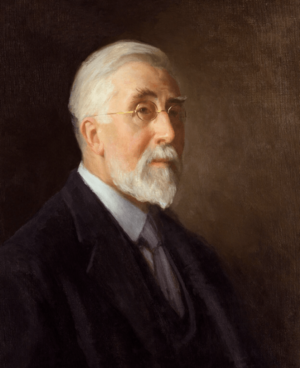Ninian Comper facts for kids
Quick facts for kids
John Ninian Comper
|
|
|---|---|

Sir John Ninian Comper by Beatrice Bright
|
|
| Born | 10 June 1864 Aberdeen, Scotland
|
| Died | 22 December 1960 (aged 96) Clapham, London, England
|
| Occupation | Architect |
| Spouse(s) | Grace Bucknall |
| Children | Nicholas Comper, John-Baptiste Sebastian Comper, Adrian Comper |
| Parent(s) | John Comper and Ellen (Taylor) Comper |
| Practice | Bucknall & Comper |
Sir John Ninian Comper (born June 10, 1864 – died December 22, 1960) was a famous Scottish architect. He was one of the last great architects who designed buildings in the Gothic Revival style. This style brought back the look of medieval churches.
Comper mostly worked on churches. He designed new ones, fixed old ones, and added beautiful decorations. He also created church furniture, stained glass windows, and special clothes for priests. People admired his use of bright colours and symbols. He believed churches should be perfect places for religious services. Later in his career, he mixed older Classical styles with Gothic designs. He called this "unity by inclusion."
Contents
Early Life and Education
John Ninian Comper was born in Aberdeen, Scotland, in 1864. He was the oldest son of seven children. His father, the Reverend John Comper, was a priest in the Scottish Episcopal Church. The Comper family had lived in England for a long time.
Ninian's father moved to Scotland to become a schoolteacher. He wanted to be a priest but could not join the Church of England without a university degree. So, he became a priest in the Scottish Episcopal Church instead. John Comper became well-known for helping people in the poor areas of Aberdeen. He was also important in a church movement called the Oxford Movement.
Ninian went to Kingston College in Aberdeen and Glenalmond School in Perthshire. He studied drawing at the Ruskin School of Art in Oxford for a year. After that, he moved to London to learn from famous architects. In 1888, he joined a partnership with William Bucknall.
Family Life
Ninian Comper and William Bucknall worked together until 1905. Ninian married Grace Bucknall in 1890. They had six children. Their oldest son, John-Baptiste Sebastian Comper (1891-1979), also became an architect. He designed many churches for the Roman Catholic Diocese of Northampton.
From 1912, Ninian and Grace lived in London at a house called The Priory. This house was designed by another famous architect, Decimus Burton. Ninian often invited friends like Sir John Betjeman to his home. His studio was nearby. When it was destroyed during World War II, he moved it to his garden. This building was once used by his son, Nicholas Comper (1897–1939), who designed airplanes.
Architectural Career and Notable Works
After working on many church restorations, Comper's first new church design was St Cyprian's, Clarence Gate in London. This church showed his ideas about how churches should be built for worship. People loved St Cyprian's, and Comper soon received many more projects.
His work included:
- Adding windows to the north wall of Westminster Abbey.
- Designing a special canopy (called a ciborium) and altar at St Peter's Church, Huddersfield. This was to remember those who died in the Great War.
- Building the Church of St Mary the Virgin, Wellingborough.
- Creating St Michael & All Angels, Inverness.
- Designing the Lady Chapel at Downside Abbey in Somerset.
- Working on the Lady Chapel and gilded paintings at All Saints, Margaret Street.
- Designing St Martin's Chapel (1913) at Chailey Heritage School with his son Sebastian.
- Designing the main building for young children at St Mary & St John School in Oxford. This school is now called the Comper Foundation Stage School.
Comper also completely rebuilt and redesigned the church at Church of St Giles, Wimborne St Giles, Dorset. This church had been almost completely destroyed by a fire in 1908.
The English Altar
Comper was known for designing altars in a medieval style, called the 'English altar'. This style was first brought back by A.W. Pugin. An 'English altar' has special posts called riddel posts around it, with curtains hanging from them. Sometimes, it also has a small shelf called a gradine. Even though it's called 'English,' this style was also used in other parts of Europe.
Comper designed many beautiful altar screens, known as reredos. These were inspired by medieval designs. An example can be seen at Wymondham Abbey in Norfolk.

Later Works and Recognition
After the First World War, Comper designed the Welsh National War Memorial. It was unveiled in 1928 in Cathays Park, Cardiff. In the late 1930s, he designed St Philip's Church near Portsmouth. This church had a very original design with the altar in the center. This idea was popular after World War I because it made the altar the main focus. However, some people thought his Gothic style was old-fashioned by then.
Comper's only work in the United States was the Leslie Lindsey Chapel in Boston. This chapel is part of Emmanuel Episcopal Church. Comper designed the altar, screen, pulpit, lectern, statues, furniture, and stained glass windows for the chapel. It remembers Leslie Lindsey and her husband, who died when the Lusitania ship was sunk in 1915.
King George VI made Ninian Comper a knight in 1950. Sir John Ninian Comper died on December 22, 1960, in London. His body was cremated, and his ashes were buried under the windows he designed in Westminster Abbey.

